Jasper Lake Fanless Showdown: ECS LIVA Z3 and ZOTAC ZBOX CI331 nano UCFF PCs Review
by Ganesh T S on July 8, 2022 8:30 AM EST- Posted in
- Systems
- ZOTAC
- Fanless
- ECS
- Passive Cooling
- UCFF
- Mini-PC
- Jasper Lake
System Performance: Miscellaneous Workloads
Standardized benchmarks such as UL's PCMark 10 and BAPCo's SYSmark take a holistic view of the system and process a wide range of workloads to arrive at a single score. Some systems are required to excel at specific tasks - so it is often helpful to see how a computer performs in specific scenarios such as rendering, transcoding, JavaScript execution (web browsing), etc. This section presents focused benchmark numbers for specific application scenarios.
3D Rendering - CINEBENCH R23
We use CINEBENCH R23 for 3D rendering evaluation. R23 provides two benchmark modes - single threaded and multi-threaded. Evaluation of different PC configurations in both supported modes provided us the following results.
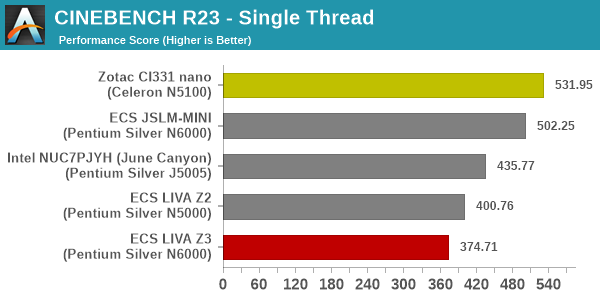

The ZOTAC CI331 nano, with its PL1 limit set to 7W, while the LIVA Z3 / JSLM-MINI have it at 6W. Coupled with the thermal throttling in the LIVA Z3, it is no surprise that the CI331 nano comes out on top in the single-threaded case despite its lower advertised clocks. The JSLM-MINI leaves the Z3 behind due to the thermal throttling issue. With multiple threads in the picture, the actively cooled June Canyon NUC with its higher power budget takes the crown.
Transcoding: Handbrake 1.5.1
Handbrake is one of the most user-friendly open source transcoding front-ends in the market. It allows users to opt for either software-based higher quality processing or hardware-based fast processing in their transcoding jobs. Our new test suite uses the 'Tears of Steel' 4K AVC video as input and transcodes it with a quality setting of 19 to create a 720p AVC stream and a 1080p HEVC stream.
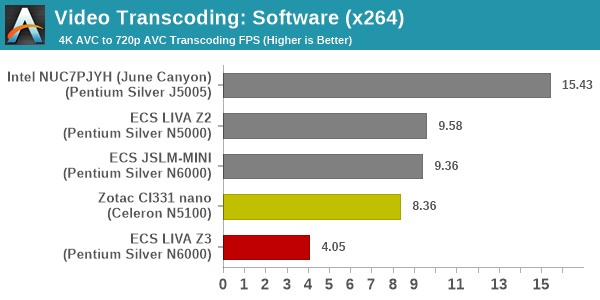
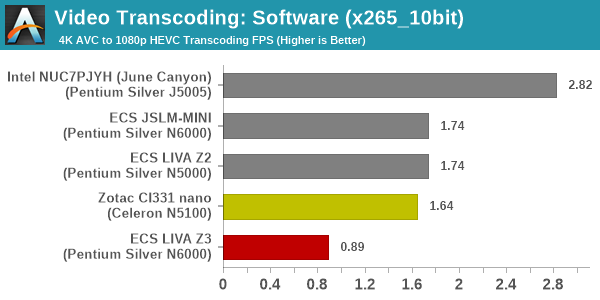
The factors influencing the software transcoding rate are power budget and core count. While the latter is the same for all systems (four cores with one thread per core), the power budget for the June Canyon and its active cooling (allowing it to maintain 10W throughout) help it in coming out on top. The ZBOX suffers slightly in this sustained loading test. As we shall see in a later section, the system is not up to the task of sustaining 7W over extended durations.
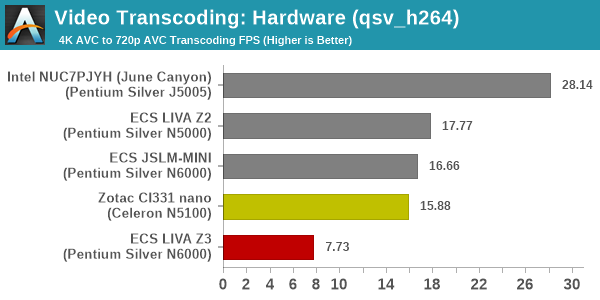
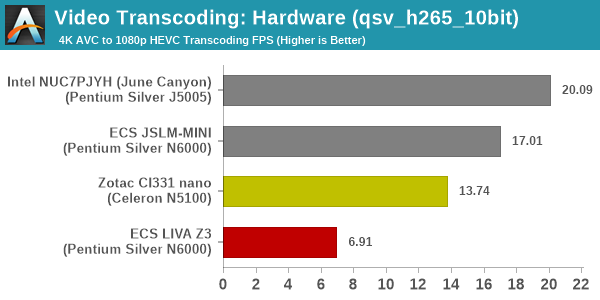
Hardware-accelerated transcoding rates are a function of GPU clock rates and power budget. The actively-cooled Gemini Lake system with its higher iGPU power budget leads the pack. The close numbers for LIVA Z2 and JSLM-MINI for AVC encoding show that the QuickSync engine itself doesn't have performance improvements in going from Gemini Lake to Jasper Lake. The Z3 and the CI331 nano both appear to be throttled in the HEVC transcoding test.
Archiving: 7-Zip 21.7
The 7-Zip benchmark is carried over from our previous test suite with an update to the latest version of the open source compression / decompression software.
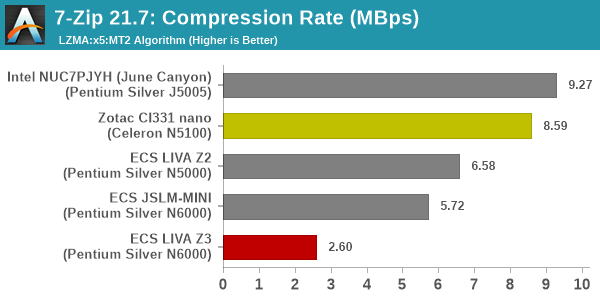

Power budget matters for the relatively short-running 7-Zip benchmark. Ignoring the actively-cooled June Canyon, we see the 7W PL1 limit of the CI331 nano helping it to lead the pack among the passively-cooled systems.
Web Browsing: JetStream, Speedometer, and Principled Technologies WebXPRT4
Web browser-based workloads have emerged as a major component of the typical home and business PC usage scenarios. For headless systems, many applications based on JavaScript are becoming relevant too. In order to evaluate systems for their JavaScript execution efficiency, we are carrying over the browser-focused benchmarks from the WebKit developers used in our notebook reviews. Hosted at BrowserBench, JetStream 2.0 benchmarks JavaScript and WebAssembly performance, while Speedometer measures web application responsiveness.
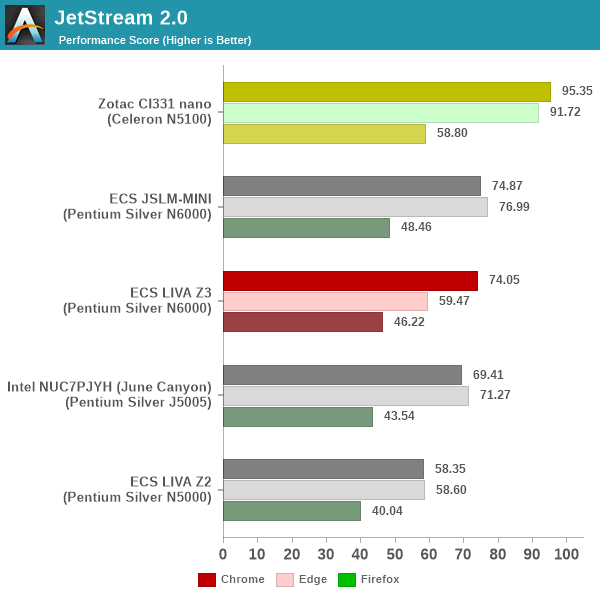
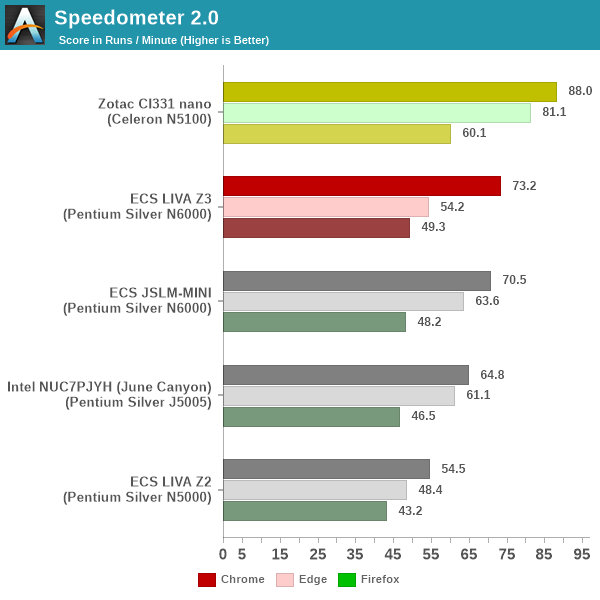
From a real-life workload perspective, we also process WebXPRT4 from Principled Technologies. WebXPRT4 benchmarks the performance of some popular JavaScript libraries that are widely used in websites.
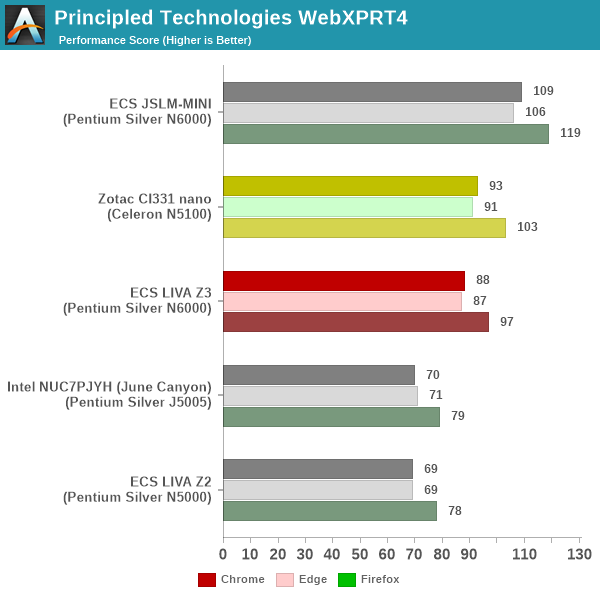
The microarchitectural improvements in Jasper Lake come to the fore in these benchmarks. Despite the higher power budget and active cooling, the June Canyon NUC with a 10W Gemini Lake processor is left well behind by all the passively-cooled Jasper Lake systems. WebXPRT4, in particular, is long-running and reflective of typical web browser usage. The fact that the fanless systems still come out with better scores despite any thermal throttling reflects well on the improvements in Tremont over Goldmont Plus.
Application Startup: GIMP 2.10.30
A new addition to our systems test suite is AppTimer - a benchmark that loads up a program and determines how long it takes for it to accept user inputs. We use GIMP 2.10.30 with a 50MB multi-layered xcf file as input. What we test here is the first run as well as the cached run - normally on the first time a user loads the GIMP package from a fresh install, the system has to configure a few dozen files that remain optimized on subsequent opening. For our test we delete those configured optimized files in order to force a fresh load every second time the software is run.
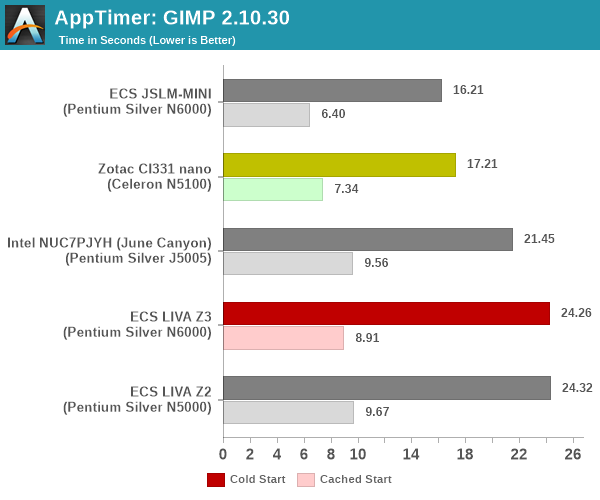
As it turns out, GIMP does optimizations for every CPU thread in the system, which requires that higher thread-count processors take a lot longer to run. So the test runs quick on systems with fewer threads, however fast cores are also needed. The thread count for all processors are the same in the considered systems. Since it boils down to fast cores, the power budget and the ability to sustain it helps. As we shall see in a later section, the JSLM-MINI is the least susceptible to thermal throttling, and that works in its favor.










52 Comments
View All Comments
xol - Friday, July 8, 2022 - link
Correction (?)Neither of these reviewed products has a Intel UHD Graphics 605 .. (that's a 14nm Gemini part with 18 EU eg here https://ark.intel.com/content/www/us/en/ark/produc...
.. Intel seems to have not publisher a 'number' for this iGPU and seems to distinguish them by number of EU eg Jasper Lake 24EU eg https://www.intel.co.uk/content/www/uk/en/products...
xol - Friday, July 8, 2022 - link
Somehow messed up the link :UHD 605 https://ark.intel.com/content/www/us/en/ark/produc...
mode_13h - Friday, July 8, 2022 - link
Thanks for your coverage of fanless mini-PCs. However, I really wish you'd include something with "big cores", so we can get a sense of the scale of performance difference between them and Tremont.Another nice-to-have would be at least a few benchmarks including a Raspberry Pi 4. However, it has serious thermal throttling issues, unless it's actively cooled or you use a substantial passive cooling solution.
mode_13h - Friday, July 8, 2022 - link
I guess the ideal comparison would be a Tiger Lake-based system, since that's the same vintage and similar manufacturing tech as Tremont. Probably much harder to find in a fanless mini-PC, unless we're talking about an industrial PC, but I'd love even to see a comparison between two NUCs: Tiger Lake vs. Tremont.mode_13h - Friday, July 8, 2022 - link
Or maybe Ice Lake would be even better, but did they make Ice Lake-based NUCs?abufrejoval - Thursday, July 14, 2022 - link
Yes, Tiger Lake NUCs were made, but also very hard to come by: I have both.In a way they are perfect to showcase the benefit of E/P cores …in the case of Intel: AMD is really another story.
The two NUCs look nearly identical on the outside, but inside they are very different beasts.
For starters: The Tiger Lake NUC11 (i7-1165G7 with 96EU Xe iGPU) is configured with a 64 Watt PL2, a rather long TAU and even the PL2 is 30 Watts by default, I believe. There is a reason it comes with a 90 Watts power brick! I changed PL2 to 50, TAU to 10 seconds and PL1 to 15 Watts to ensure the fan would never howl they way it does with the defaults.
I’ve seen HWinfo report a 5GHz maximum clock, but 4.7GHz is the official top speed. It’s at 64 Watts and near 5GHz clocks that I have measured 1707/5808 Geekbench 4 results on Linux (always a bit faster than on Windows). Jasper Lake doesn’t quite play in the same league at 781/2540 using 3.3 GHz and 10 Watts. In Watts/compute power Tiger Lake looks rather worse than Jasper Lake, but when it comes to rendering a complex web page or recalculating a giant Excel sheet, its sprinting power certainly has it appear much faster.
At 64 Watts the Tiger Lake is a desktop CPU, shoehorned into mobile power envelopes. And when it’s constrained to the levels that passive cooling can manage (see the Supermicro SYS-E100-12T-H review here), it really struggles to deliver that performance. The great thing about the Tiger Lake NUC is that you can change PL1, PL2 and TAU to pretty much anything you want and when you set it to the 10 Watts the Jasper Lake gets to use as an absolute maximum, it starts to do rather badly.
Some of that is because the iGPU always gets preference, leaving close to nothing to the CPU. But some of that is that the remaining power budget forces very low frequencies, where the big Core CPU loses against the Atom cores running at a full speed with these Watts.
Jasper Lake, like all the other Atoms since the J1900, never slows down. I’ve never seen it drop below its “Turbo” clock unless idle, even on a mix of Prime95 and Furmark, and I’ve never seen it exceed 10 Watts of combined CPU+GPU power consumption either.
I also have two Ryzen 5800U based notebooks (1443/7855 on Geekbench4), one of which can be switched between 15 and 28 Watts of TDP. When Tiger Lake and Zen 3 are strictly set to the same power levels, Tiger Lake has to run much slower even with half the cores: Ryzen beats it with a much smaller energy footprint per core. But with Tiger Lake left at the default NUC settings (which a battery powered notebook could not support), its four cores will beat an eight core Zen 3 at 15 Watts in Geekbench, which luckily never seems to exceed TAU.
Intel needs E/P because P cores need too much power at the clock rates they require to beat a Ryzen core, and only with E cores they can hit the efficiency of Zen cores in fully multi-threaded loads.
mode_13h - Thursday, July 14, 2022 - link
Wow, another awesome post! Thanks for taking the time to relate your findings. Very interesting!> the iGPU always gets preference, leaving close to nothing to the CPU.
Very key point, but also one that Intel could conceivably address, to some extent, in future BIOS updates. Not that they're likely to, if it had been on the market for a while when you tested, but it's conceivable.
> in Geekbench, which luckily never seems to exceed TAU.
Another great point! I have never run Geekbench myself, and I haven't noticed reviewers mention this key detail.
Foeketijn - Saturday, September 3, 2022 - link
Don't you want to write for Anand?stanleyipkiss - Friday, July 8, 2022 - link
Zotac makes a fanless zbox with a 1165G7xol - Friday, July 8, 2022 - link
Benches I've seen suggest both are very similar in multi to a i3 low power Skylake eg a ie-6100T (2core 4 thread very common thin client chip) - the gfx capability also seems also a close match for the 24EU part [probably a very similar part with improved HEVC support] (the 32EU N6000 should be better)For single threaded the old Skylake is ~+50% faster., and from Skylake to Alder Lake it's nearly 2x , so nearly 3x from N5100 to i5-12500 for single thread
I have an old fanless Atom Z3735F (22nm) and these new SoCs are a impressive step up (~7x both cpu and gpu) -- I think the Pi Model B latest is very roughly 2x better than that nut no where near the 5100T in any metric.
tldr both benches would have been a wash one way of the other.